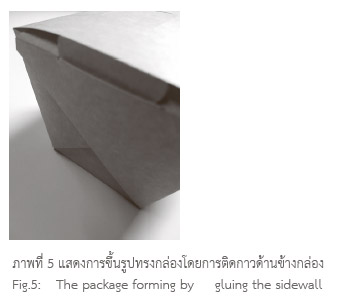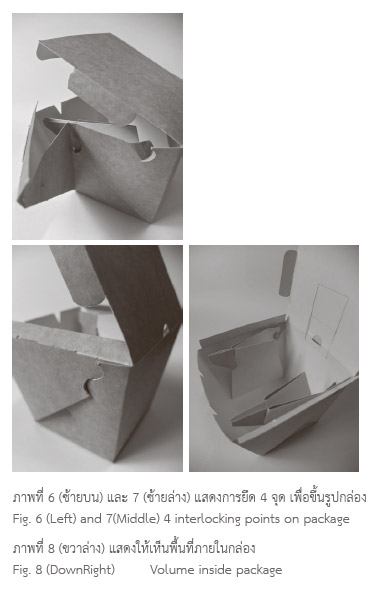นักออกแบบหลัก : Principal Designer
ผศ. อินทิรา นาควัชระ (ออกแบบโครงสร้างบรรจุภัณฑ์)
Asst.Prof. Indrira Nakwatchara (Structural Design)
ผู้ช่วยนักออกแบบ : Assistant Designer
ผศ. สุพิชญา เข็มทอง (ออกแบบกราฟิกบนบรรจุภัณฑ์)
Asst.Prof. Supichaya Khemthong (Graphic Design)
ผศ. ดร. จิรวัฒน์ วงศ์พันธุเศรษฐ์ (ที่ปรึกษา)
Asst.Prof.Dr. Jirawat Vongphantuset (Adivsor)
มหาวิทยาศิลปากรมีความประสงค์จะปรับปรุงบรรจุภัณฑ์ เพื่อบรรจุอาหารพร้อมรับประทานที่มีแจก (หรือจัดจำหน่าย) ในกิจกรรมและงานราชการต่าง ๆ ที่จัดขึ้นภายในมหาวิทยาลัย ทั้งนี้เพื่อเป็นการส่งเสริม ภาพลักษณ์ของมหาวิทยาลัยและสร้างความสะดวกมากขึ้นในการรับประทานอาหารของผู้มาร่วมงาน โดยอาหารที่จะบรรจุในบรรจุภัณฑ์นี้ เป็นอาหารจานเดียวทั่วไปที่ปรุงสุก แล้วพร้อมรับประทาน เช่น ข้าวราดแกง ก๋วยเตี๋ยว ขนมจีน เป็นต้น
Silpakorn University has a requirement to develop a set of ready-to-serve food package for its activities and internal affairs. This development is to promote the university’s image and convenience to its activities’ participants. Food to be served with these packages is cooked and ready to eat within a package, for instance: Curry on Rice, Noodles, or Rice Vermicelli.
ในการออกแบบ มีขั้นตอนการออกแบบอยู่ 2 ขั้นตอนหลัก คือ ขั้นตอนการออกแบบโครงสร้าง (โดยทางมหาวิทยาลัยกำหนดให้ใช้วัสดุกระดาษเป็นหลัก) และขั้นตอนการออกแบบกราฟิก
There are 2 main design stages : Structural Design (the university require the use of paper as a main material) and Graphic Design.
ขั้นตอนการออกแบบโครงสร้าง ได้นำหลักการขึ้นรูปทรงภาชนะบรรจุอาหาร ที่ทำจากใบตองของไทย รูปทรงต่าง ๆ มาดัดแปลง เนื่องจากเห็นว่าภาชนะใบตองของไทยส่งเสริมภาพลักษณ์ที่ดีให้กับอาหาร และยังมี ภาพลักษณ์ที่เข้ากันได้กับภาพลักษณ์ของมหาวิทยาลัยศิลปากรนอกจากนี้ภาชนะใบตองขึ้นรูปจาก ใบตองแผ่น ซึ่งมีคุณสมบัติเป็นวัสดุ 2 มิติ เช่นเดียวกับวัสดุกระดาษ ที่ทางมหาวิทยาลัยกำหนดให้ใช้เป็นวัสดุหลัก ดังนั้นจึง มีแนวโน้มเป็นไปได้ที่จะนำโครงสร้างมาประยุกต์ใช้ในการออกแบบ
For the structure design : various forms of Banana-Leaf Thai traditional package have been used for design development – Thai Banana-Leaf Package conveys positive image on both Thai food and Silpakorn identity. Moreover, Thai Banana-Leaf Packages are formed from 2 dimensional flat leaves, which are the same forming principle as Silpakorn assigned paper material. Therefore, Thai Banana-Leaf Package has possibilities to be applied to the package’s structure design.
ในการออกแบบแบบร่าง (Sketch Design) รูปทรงที่ได้เกิดจากการใช้วิธีสอดกระดาษทบไปมา เพื่อทำให้ เกิดรูปทรงโดยไม่ได้ใช้กาวยึด และพื้นของบรรจุภัณฑ์ก็ไม่มีช่องหรือรูรั่ว ทำให้บรรจุอาหารได้อย่างมั่นใจว่า ไม่ทะลุพื้นกล่องออกมา โครงสร้างของบรรจุภัณฑ์ที่ได้เป็นไปตามภาพที่ 1
For the sketch design, the form created derives from paper-crisscross -inserted principle to create form without using any glue. The bottom of the package has neither space nor hole, which can contain food with confidence of leaking. (Figure 1)
เมื่อได้หลักการขึ้นรูปกระดาษเพื่อให้เกิดรูปทรงตามที่ต้องการแล้ว จึงได้พัฒนาแบบต่อให้มีฝาปิด (เพื่อให้ ถูกสุขลักษณะของภาชนะบรรจุอาหาร) ดังนั้นจึงได้ปรับปรุงแบบให้มีสันกล่องทั้งสี่มุม เพื่อว่าเวลามีฝากล่อง จะทำให้ปิดฝาได้สนิท ดังภาพที่ 2
When designers achieve the paper forming principles,the next development is to design the lid for food hygiene. The 4 folding corners are added to the design in preparation for the fitting of the lid. (Figure 2)
จากนั้นจึงพัฒนาแบบต่อโดยออกแบบให้มีฝาปิดติดกับตัวบรรจุภัณฑ์ ปรากฏว่า แม้ฝาปิดจะปิดลงมา ได้พอดี แต่เกิดปัญหาการโก่งตัวด้านข้างของบรรจุภัณฑ์ เนื่องจากจุดที่โก่งออกนั้นมีการพับทบ (เพื่อขึ้นรูปให้เป็นกล่อง) และมีกระดาษสอดขึ้นกันไปมาหลายชั้น ดังภาพที่ 3 – 4
The further development is for the package to have a connected lid. Although the lid can be folded and fit with the package, the folding lid causes curves and space on the sidewall, due to many layers of folding and crisscrossing of the paper in order to form the sidewall of the package.
จึงมีการพัฒนาแบบเพื่อแก้ปัญหาไม่ให้เกิดการโก่งตัวและปิดฝาได้สนิท โดยการเพิ่มลิ้นด้านข้างของฝาบน เพื่อให้มาล๊อคกับตัวกล่อง ส่วนการแก้ปัญหาเรื่องความหนาของกระดาษที่ทบไปมาจนหนาของด้านข้างกล่องนั้น มีการคิดแก้ปัญหาในหลายแนวทาง ได้แก่
Further development aims to eliminate the sidewall curvature problem and for the lid to be closed tightly by adding flaps to the side of the lid to lock with the package on closing. The several layers of paper problem on sidewalls is corrected with several designs.
จึงมีการพัฒนาแบบเพื่อแก้ปัญหาไม่ให้เกิดการโก่งตัว และปิดฝา ได้สนิท โดยการเพิ่มลิ้นด้านข้างของฝาบนเพื่อให้มาล๊อคกับตัวกล่อง ส่วน การแก้ปัญหาเรื่องความหนาของกระดาษที่ทบไปมาจนหนาของด้านข้าง กล่องนั้น มีการคิดแก้ปัญหาในหลายแนวทาง ได้แก่
Further development aims to eliminate the sidewall curvature problem and for the lid to be closed tightly by adding flaps to the side of the lid to lock with the package on closing. The several layers of paper problem on sidewalls is corrected with several designs.


เมื่อพิจารณาในเงื่อนไขของความแข็งแรง ง่ายต่อการประกอบ ขึ้นรูปกล่อง กล่องเมื่อขึ้นรูปแล้ว สามารถเรียงซ้อนได้ดีเพื่อพร้อมใช้งาน ความคุ้มค่าของใช้สอย และการประหยัดพื้นที่ในการจัดเก็บบรรจุภัณฑ์ เปล่าเมื่อยังไม่ได้ใช้งาน ปรากฏว่า กล่องแบบที่ขึ้นรูปโดยการยึดข้า งกล่องแบบ 2 จุด (ข้างละ 1 จุด) โดยไม่ใช้กาว มีความเหมาะสมที่สุดที่ จะนำไปพัฒนาแบบต่อไป
With considerations of rigidity, ease of assembling, stacking of the finished package, value of usability, and space saving on package stocking – the 2 Point Design model without glue is the most suitable design to be developed further.
เมื่อได้รูปแบบของโครงสร้างบรรจุภัณฑ์ที่ชัดเจนแล้ว (ดังรูปที่ 11) ขั้นต่อไปคือ การพัฒนาเรื่องของขนาดและรูปทรงบรรจุภัณฑ์ จาก การสำรวจรูปแบบอาหารคาวที่นิยมแจก (หรือจำหน่าย) ในงานของ มหาวิทยาลัยส่วนใหญ่มักเป็นแห้งหรือเปียก (คือ มีนำขลุกขลิก) โดยแบ่ง เป็นหลัก ๆ 2 ประเภท ได้แก่ อาหารประเภทข้าว (ซึ่งมีทั้งแบบอาหาร จานเดียว เช่น ข้าวมันไก่ ข้าวหน้าเป็ด ฯลฯ และ แบบข้าวราดแกง 1-2 อย่าง) และ อาหารประเภทเส้น (เช่น ก๋วยเตี๋ยว ผัดไท ขนมจีน ราดหน้า ผัดซีอิ๊ว สปาเก๊ตตี้ ฯลฯ) จึงได้ออกแบบให้มี 2 ขนาด คือรูปทรงแบบถาด หรือจานสำหรับอาหารประเภทข้าวและรูปทรงแบบชามสำหรับอาหาร ประเภทเส้น ดังรูปที่ 12 โดยออกแบบให้ฝาของบรรจุภัณฑ์สามารถเสียบ ตะเกียบ หรือช้อนได้หลากหลายขนาดและรูปแบบ ดังรูปที่ 13 – 14 และ เป็นจุดที่ใช้ระบายความร้อนของอาหารได้ด้วยเมื่อปิดฝาแล้ว ดังรูปที่ 15 – 16
When the structure design has been finalized (Figure 11), the next stage is to develop the package’s proportion and form. From the survey in kinds of food that are popular to hand-out (or sell) in the university’s affairs, most food are either dry or wet (juicy). Hand-out food can be categorized in 2 kinds: Rice (both one-dish meal, ex. Chicken with Source over Rice, Duck with Source over Rice, Rice with 2 kinds of curry over the top) and Noodles (Pad-Thai, Rice Vermicelli, Fried noodle with pork and broccoli, Stir-fried Thai Style small rice noodle, Spaghetti, etc.) The package is then designed to have 2 forms: tray or plate-form for rice-food, and bowl-form for noodle-food (Figure 12). The package’s lid is designed to be able to insert various sizes of chopsticks and spoons (Figure 13-14), this insert space also ventilate heat when the lid is closed.
ขั้นตอนการออกแบบกราฟิกบนบรรจุภัณฑ์ ได้ออกแบบใน 2 แนวทาง แนวทางแรก มาจากแนวคิดเริ่มต้น คือภาชนะใบตองจึงนำสีสันลวดลายของใบตองมาเป็นลวดลายบน กล่องบรรจุภัณฑ์ ดังภาพที่ 17 – 18
For the graphic on package, 2 concepts have been explored : the first concept is to incorporate the color and pattern of Banana-Leaf package.
แนวทางที่สอง พัฒนาจากกราฟิกของบรรจุภัณฑ์ที่มหาวิทยาลัยเคยใช้มาก่อนหน้า นี้ ซึ่งเป็นรูปแบบกราฟิกอัตลักษณ์ของมหาวิทยาลัยศิลปากร พิมพ์ 4 สีบนกระดาษการ์ดสี ขาว ดังภาพที่ 19
The second concept of development is from the previous-used university’s package by printing on white card paper (Figure 19).
เนื่องจากมหาวิทยาลัยได้เลือกแบบบรรจุภัณฑ์ ขนาดเล็ก และระบุให้ใช้กระดาษสีน้ำตาล ดังภาพ ที่ 20 แนวทางนี้จึงยังคงต้องรักษารูปแบบกราฟิก อัตลักษณ์ของมหาวิทยาลัยศิลปากรเอาไว้ คือรูป แบบของตัวอักษรทั้งภาษาไทยและภาษาอังกฤษ ตราสัญลักษณ์ และกราฟิกตกแต่งบรรจุภัณฑ์ โดย ปรับการออกแบบ การจัดวางและระบบการพิมพ์ ให้เข้ากับวัสดุที่ใช้ทำบรรจุภัณฑ์ ซึ่งเป็นกระดาษสี น้ำตาลที่มีต้นทุนถูกและเหมาะสมกับบรรจุภัณฑ์ ประเภทใช้แล้วทิ้ง แต่มีข้อเสียคือ ไม่เหมาะกับการ พิมพ์ 4 สี เพราะสีจะหม่นลงและมีการดูดซับสีสูง ทำให้ความคมชัดของกราฟิกลดลง หากไม่มีการพิมพ์ สอดสีรองพื้นไว้ก่อน ซึ่งจะเพิ่มต้นทุนในการผลิตโดย ไม่จำเป็น ดังนั้นจึงเลือกใช้การพิมพ์สีเดียว โดยเลือก สีเขียวตังแซ ซึ่งเป็นสีประจำมหาวิทยาลัยและลด ค่าน้ำหนักของสี ให้เกิดความเคลื่อนไหวของกราฟิก สร้างความงามและยังคงรักษารูปแบบกราฟิกอัต ลักษณ์ของมหาวิทยาลัยศิลปากรเอาไว้ และยังช่วยลด ต้นทุนในการผลิตได้อีกทางหนึ่งด้วย ดังภาพที่ 21-22
The university chooses small size packaging made from brown-paper (Figure 20). Therefore, this concept must be designed to preserve Silpakorn’s identity graphic such as Thai and English typeface, logotype, and packaging’s decorative graphic – by adjusting layout and printing system to accommodate inexpensive brown-paper production, and to serve its disposable used. Brown-paper is not suitable for Offset- Printing, due to its nature of dulling the printed color and high in color absorbance, which would decrease the clarity of graphic design on packaging – if there is no background color printing before Offset-Printing – which will increase cost of production. Therefore the one-colored printing system is the most suitable choice: Tang-Zae Green – Silpakorn University color has been selected and used in variety shades to create graphic movement, aesthetics and to preserve Silpakorn’s identity graphic, yet limit cost of production (Figure 21-24).
บรรจุภัณฑ์ชุดนี้ยังอยู่ในขั้นตอนการดำเนินงาน ดังนั้นรูปแบบของ โครงสร้างและกราฟิก อาจมีการเปลี่ยนแปลงแก้ไขเพิ่มเติม เนื่องจากยัง ไม่ได้ข้อสรุปจากทางมหาวิทยาลัย จึงยังไม่สามารถดำเนินการทำต้นแบบ จากโรงพิมพ์อุตสาหกรรม เพื่อทดสอบผลการออกแบบได้อย่างสมบูรณ์
This set of packaging is still under the development, therefore structure and graphic may still be corrected. Await the university’s feedback, prototype has not yet been produced from the printing house for the final test results.
